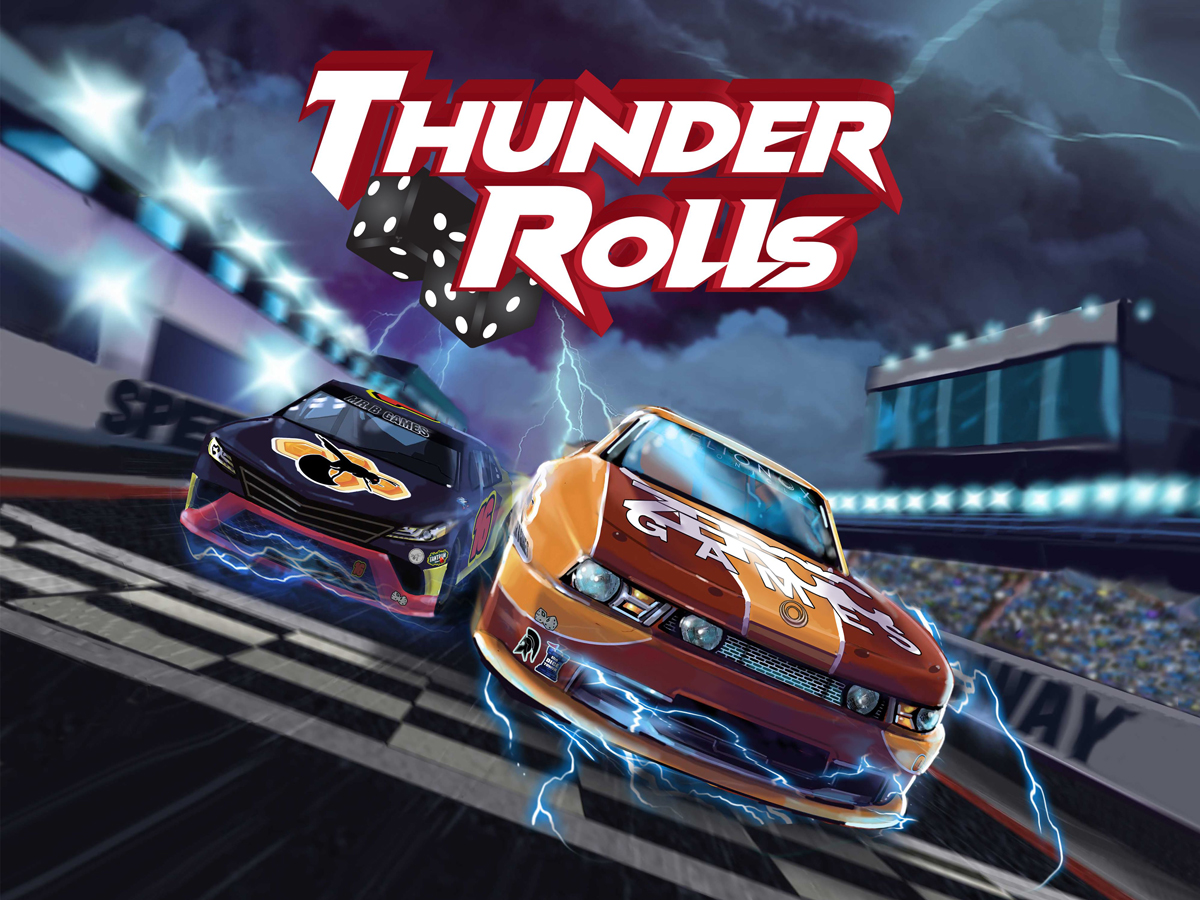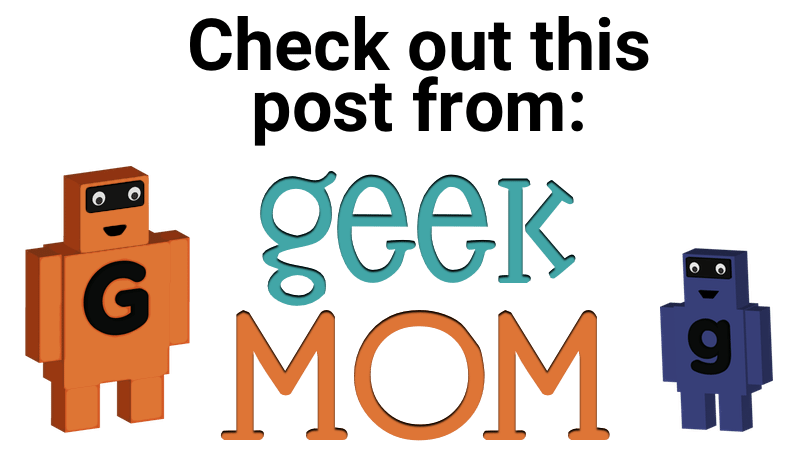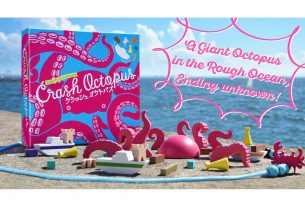You can almost hear the revving engines, squealing tires, and the roar of the crowds in Thunder Rolls. Get ready to race!
What Is Thunder Rolls?
Thunder Rolls is a stock car racing game for 1 to 8 players, ages 10 and up, and takes about 30 to 60 minutes to play. It’s currently seeking funding on Kickstarter, with a pledge level of $49 for a copy of the game. (Some higher limited tiers are available if you want to sponsor a race or a car.) It’s definitely something that kids will be able to play, though it will help to have an older or experienced player to keep track of the rules, since some of the actions can be a little confusing at first. The game length is affected by the number of players and the type of race.
Thunder Rolls was designed by Richard Launius and co-published by Mr. B Games and Zeroic Games, with illustrations by Jack Hoyle.
New to Kickstarter? Check out our crowdfunding primer.

Thunder Rolls Components
Note: My review is based on a prototype copy, so it is subject to change and may not reflect final component quality. The prototype only had the oval race track (instead of a double-sided board). Depending on whether stretch goals are reached during the game, there may be other components added as well. The prototype didn’t include the pole/leader token, and only had 1 cube per team rather than 2.
Here’s what will come in the box:
- Race Track board
- 8 Team cards
- 8 Race Cars
- 64 Dice (8 each in 8 team colors)
- 16 Cubes (2 each in 8 team colors)
- 12 Speed cards
- 32 Thunder cards
- 12 Hazard cards
- 16 Qualifying cards
- 16 Non-Player Action cards
- 8 Non-Player Driver cards
- Pole/Leader token
- 4 Race cards
- 8 Reference cards
The board itself is quite large at 34.5″ wide, so make sure you have a big enough space for it (plus every player needs a little bit of space for their team cards and programmed cards, and there’s a row of small cards along the bottom edge of the board as well). The final board will be double-sided, with two different tracks to use.

The cars themselves are pretty fun: they’re wide and chunky, and they look pretty great on the track. They’re not quite as big as Hot Wheels cars, but they’re close. Note that the cars in the prototype are hand-painted and stickered—the final game will include color stickers and brand stickers but the cars themselves will be gray. (You may notice that the green car has GeekDad logos on it—the publisher asked if we’d like to be included. Up to 8 backers can also get their own brands added to the sticker sheets.)
Most of the cards are small cards, and there’s room for the various decks in the center of the racetrack; they mostly just have large numbers and a few action icons on them, so there’s not a lot of room required for text, and it saves some room on the table (even though I’m generally not a big fan of small cards). We’ll get into the cards a bit more in the gameplay section. The cards do have illustrations on them—each deck has its own background illustration—though they’re fairly tiny. There are larger illustrations on the team cards and the action spaces on the board, and they’re a good mix of racing images that help set the scene.
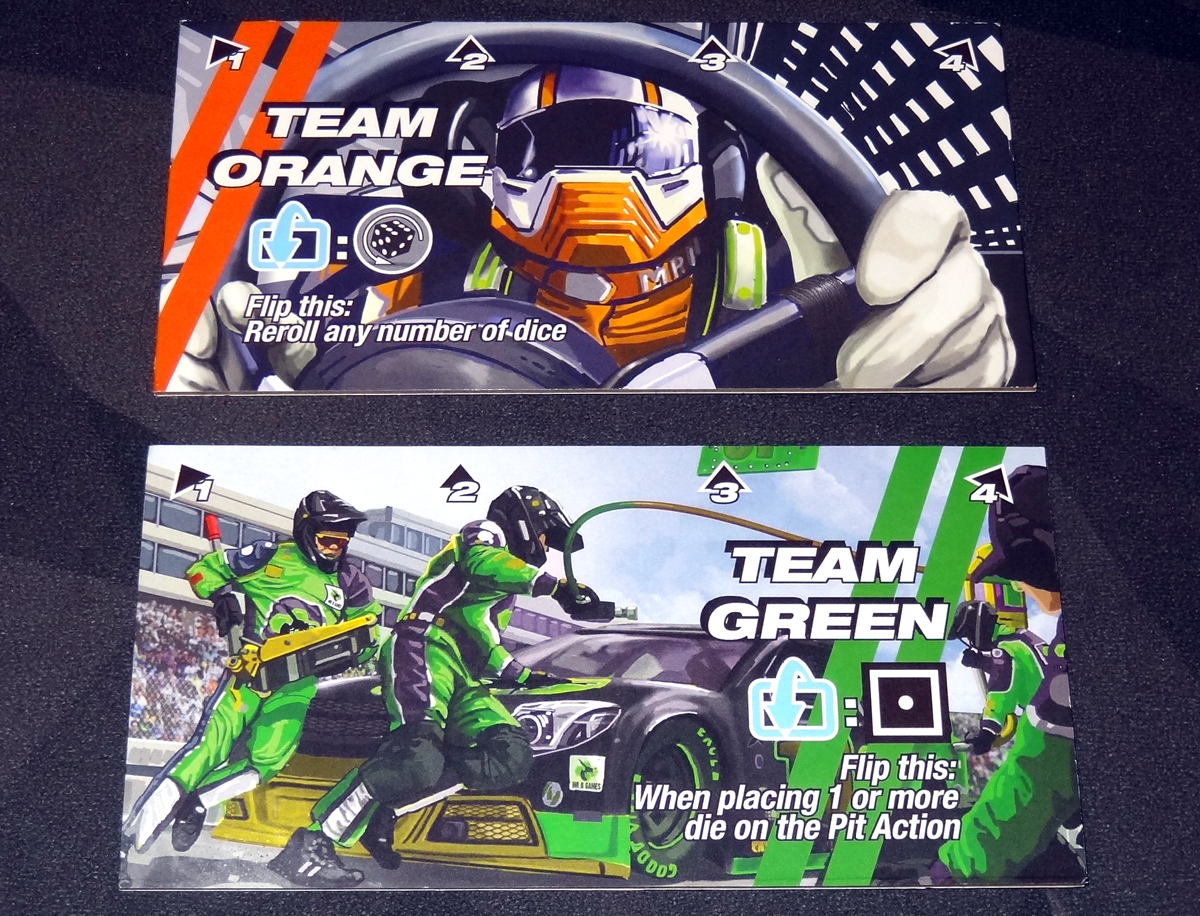
The team cards are large, tarot-sized cards, showing a driver on one side and the pit crew on the other—you flip it over when it’s been used to re-roll your dice. At the top of the card are four arrows, used for when you program your movement.
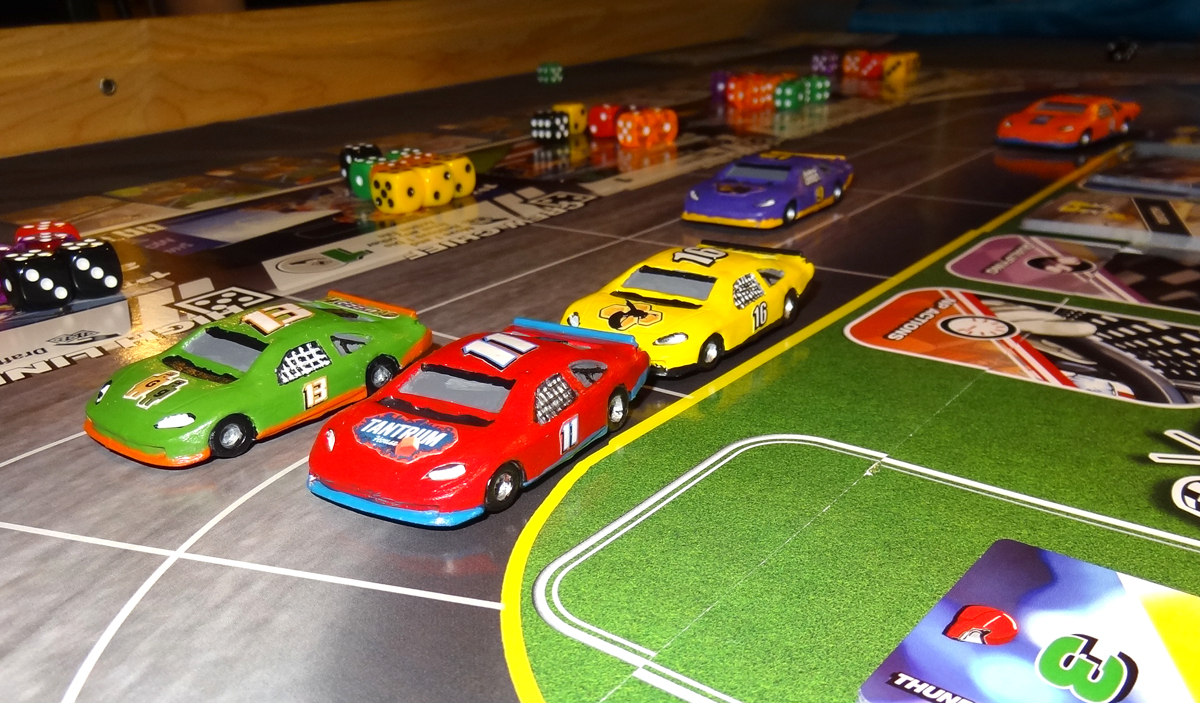
How to Play Thunder Rolls
You can download a draft of the rulebook here. Note that there are solo rules in development, but I have only played the multiplayer version.
The Goal
The goal is to win the race, of course, but you can also set up a multi-race championship and track points for each place per race.
Setup
There are a few different races to choose from: the race card indicates which side of the board to use, how many stages will be played, and whether there are any special rules for that race. For instance, the Monster Meeple 500 allows for multi-car drafting, but can also result in a massive pile-up that affects a bunch of cars at once.

Give each player a team card, race car, dice, and cubes of their chosen color. For any colors that were not chosen, place the corresponding Non-Player Driver (NPD) card nearby—the car and cubes will still be used, but not the dice.

Shuffle all of the decks individually, and place them in their spaces in the center of the board. Deal each player 2 Qualifying cards (and deal one to each NPD as well). Each player chooses one to keep and discards the other. Then all of the cards are revealed, and the cars are placed in the 8 starting spaces, with the highest Qualifying number taking the first spot. Some of the lower numbers have an ability printed on the bottom of the card—if so, the player should keep the card for use later.

Place one cube of each color on the “0” space of the scoreboard, and on the “start” space for Laps. Deal Thunder cards along the bottom of the board, 3 below each action space. The arrows indicate whether the cards should be placed face-up or face-down.
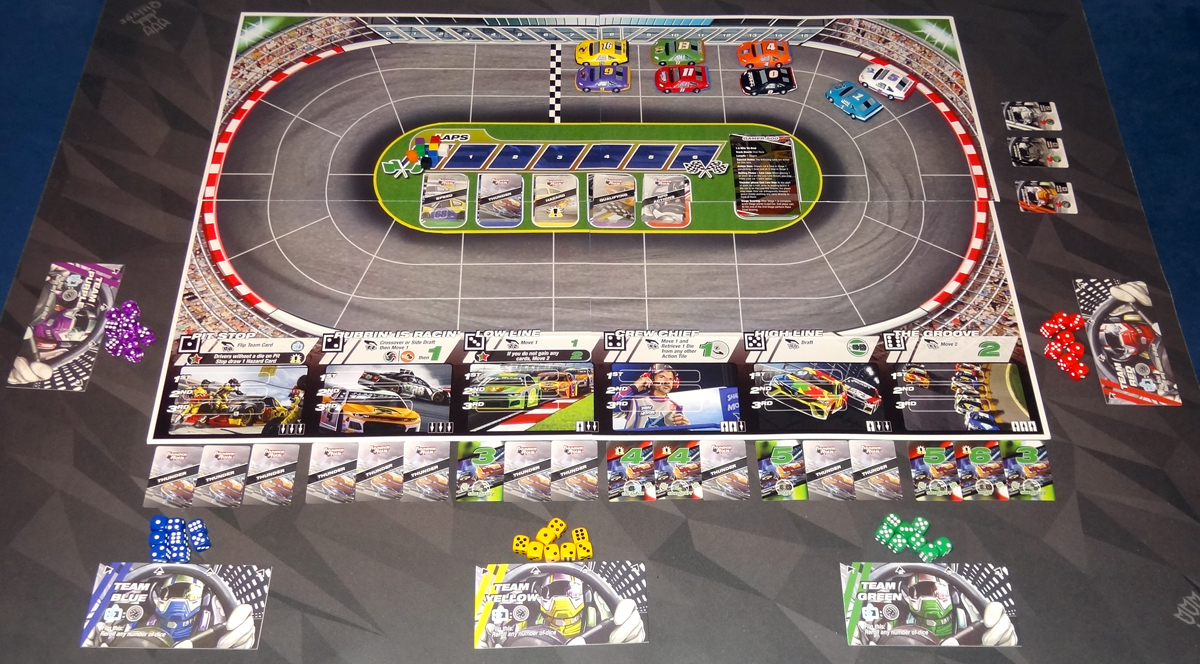
Gameplay
Most races are either 1 or 2 Stages, and each Stage has a Rolling phase followed by a Thunder phase. During the Rolling phase, players roll dice and place them into the various action spaces on the bottom of the board to take those actions and bid on the Thunder cards for that section. During the Thunder phase, players program 4 actions using Thunder cards and Speed cards, and then play them out.
Rolling Phase
Each round starts with the player in the lead position, goes clockwise around the table, and concludes with any NPDs. This is repeated until all players are out of dice.
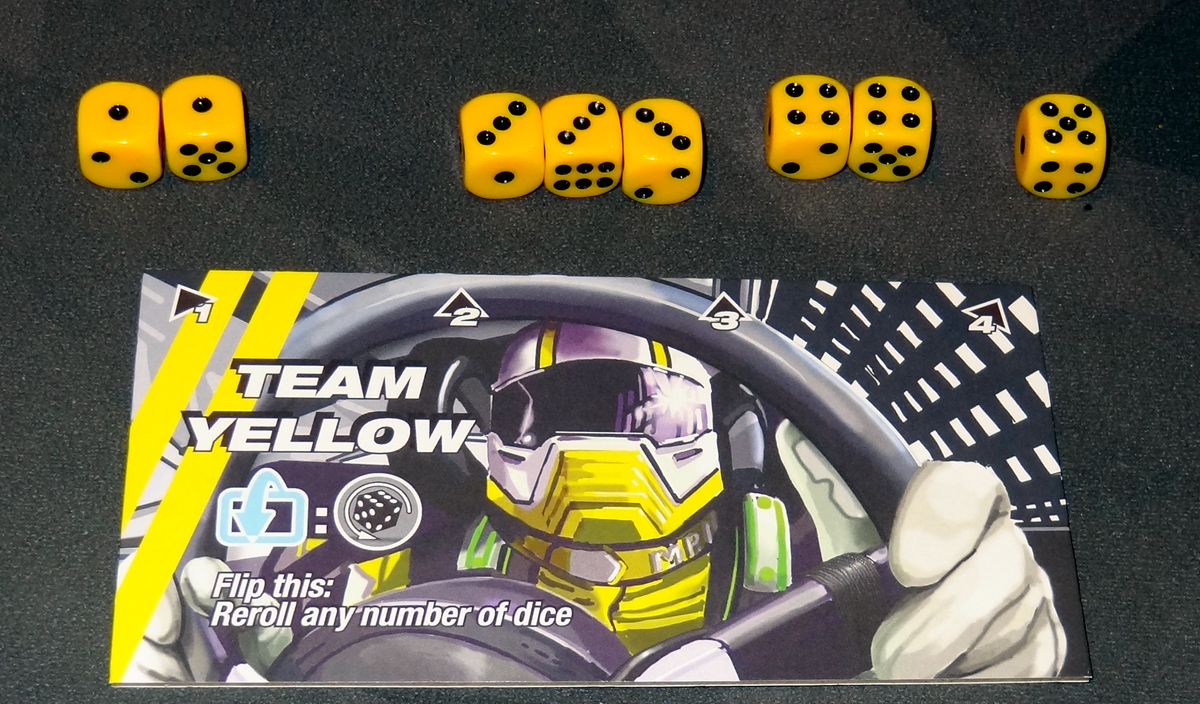
Everyone rolls the dice in their pool, and groups them by number. On your turn, you must place all of the dice of one value into the matching action space, ranked by the number of dice you have in that space. (If you’re adding dice to a space where you already had dice, this may adjust your ranking there.) Then, you may perform the action on that space.
Here are the 6 action spaces:
- Pit Stop – Flip your Team card to its active side. (An active team card may be flipped at any time to re-roll any number of your dice.)
- Rubbin’ Is Racin’ – You may do a crossover or side draft (explained later), then move 1 space.
- Low Line – Move 1 space.
- Crew Chief – You may move 1 space, and then you may retrieve 1 die from a different action space.
- High Line – Draft 1 space if possible.
- The Groove – Move 2 spaces.

After each player has placed a set of dice, flip NPD Action cards for each of the NPDs, using the “Rolling Phase” action on the top half of the card. If there’s a red helmet shown there, you also perform the bonus action shown on the NPD card. Note: if any players ran out of dice and did not place any this round, skip the NPD actions.
If any players still have dice remaining, play another round in the Rolling Phase, starting with the current lead player.

Once everyone is out of dice, you award cards and resolve awards and penalties. Reveal all the Thunder cards below the board. For each action space, the top 3 players in order get to take those Thunder cards. Any player that did not place at least 1 die in Pit Stop must draw a Hazard card. Any player who placed dice in Low Line but did not get a card gets to move 2 spaces on the track.

If there are more than 6 players, each player is dealt 1 Thunder card from the deck. Anyone who has fewer than 4 Thunder cards draws cards from the Speed deck until they have 4 race cards (not counting Hazards). Anyone who has more than 4 Thunder cards must discard down to 4.

Thunder Phase
For every Thunder card that has a Hazard symbol on it, you must roll a die—if you roll a 1, you draw a Hazard card. Each Hazard card shows where it must be placed in your program. Some Hazards have red flags—these are additional penalties you suffer if you did not take the Pit Stop action during the Rolling phase.

Then, every player programs their four race cards. (Race cards stack with the Hazard cards.)

Starting with the leader and going clockwise, players reveal the cards in the first slot and perform its action. If there’s a Hazard, reveal it and resolve it first, and then resolve your race card.
After all the players have gone, draw one NPD Action card for each NPD and use the bottom half showing the “Thunder Phase” action.
Repeat until everyone has played all 4 of their actions.
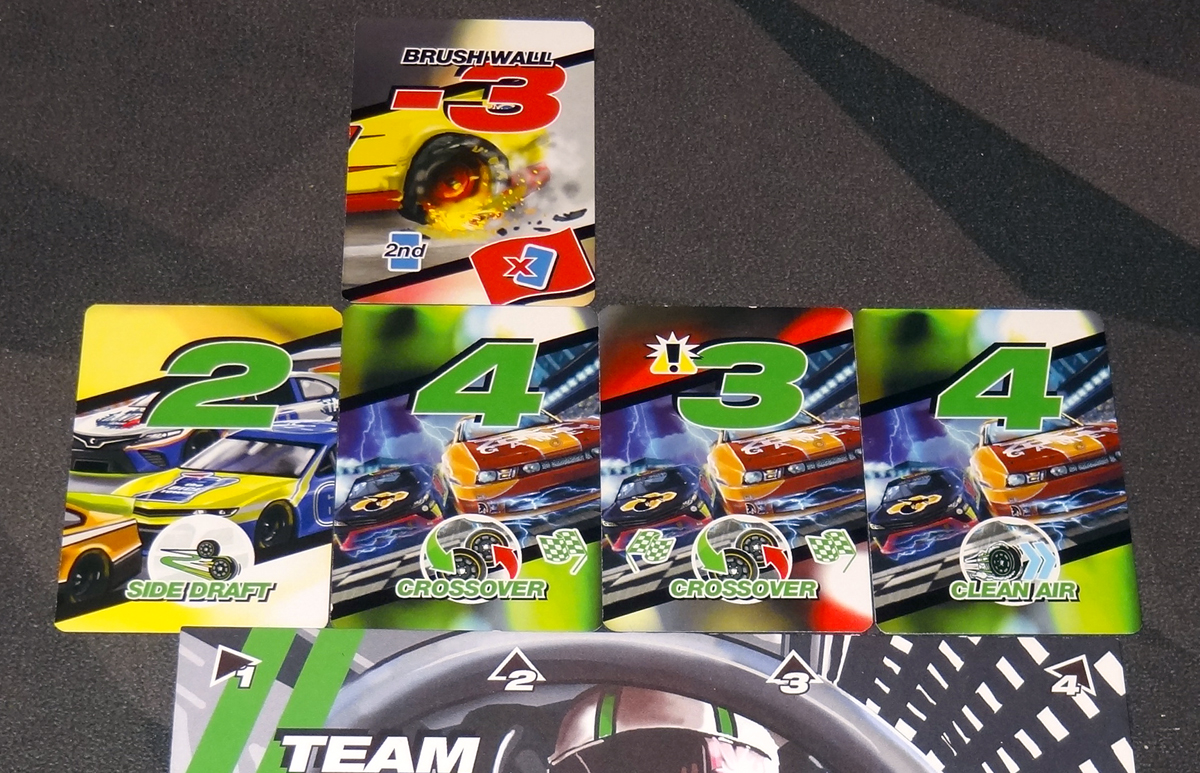
At the end of the Thunder phase, players also get bonus moves if they have matching flag icons in their program. Then, points are awarded—fewer points after the first Stage, and more points at the conclusion of the race in the second Stage. (Reshuffle cards and set up again if playing another stage, skipping the Qualifying step.)
Other Details
There are four special actions seen on some of the action spaces or on race cards:
- Clean Air – If the two spaces directly in front of you are empty at the start of your move, then add 2 movement.
- Crossover – Before or after your move, you may swap spaces with a car that is directly in front of you, or diagonally adjacent in front of you.
- Drafting – Before or after your move, if you are directly behind or in front of another car, both cars may move 1 space.
- Side Draft – Before or after your move, if there is a car directly adjacent to your side, you may push that car backward 1 space. (This may push other cars backward as well.)
Generally when you move, you may move forward orthogonally or diagonally. If your path is blocked, you may brake to stop moving, or you may push—but that can trigger a risk test, where each involved car rolls a die. Any dice that match cause those cars to move backward 2 spaces (or more if needed to reach an empty space).
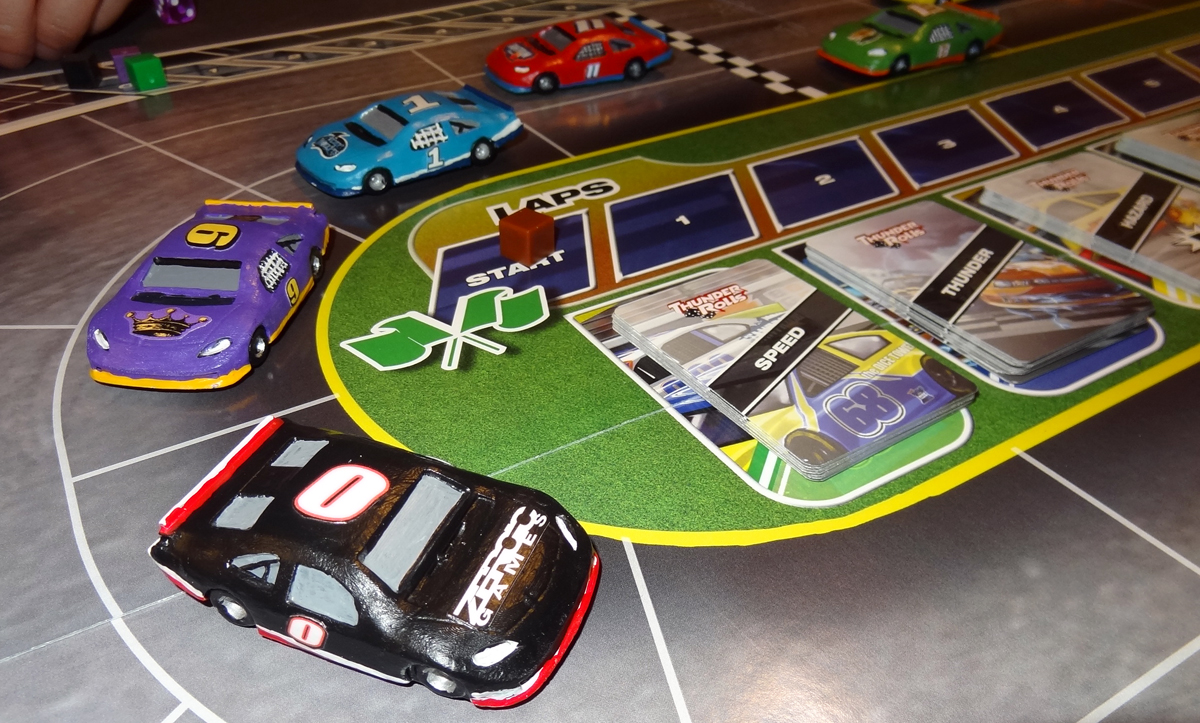
Game End
After the prescribed number of stages, the race ends, and players are placed according to their position on the track. (If playing a multi-race championship, award points and set up for the next race!)
Why You Should Play Thunder Rolls
I’m not a huge NASCAR fan, so the theme of Thunder Rolls didn’t grab me right from the start, but I do like chucking dice and programmed movement games. The fact that it was designed by Richard Launius also piqued my curiosity—he’s designed quite a few well-known games like Arkham Horror and Defenders of the Realm, and he’s a fan of stock car racing, too. So it seemed worth taking out for a few laps around the track. I didn’t have the prototype for very long, but I managed to play it a few times—admittedly with a few rules errors as we were learning or as they were being tweaked—and I had a lot of fun with it.
Taran Kratz, the developer and one of the co-publishers, told me that Thunder Rolls is better the more players you have, and I would agree. You always have 8 cars on the track regardless of the number of players, using the non-player driver cards to control the others—but, really, they’re just not as smart and can often choose actions that don’t move them at all. I haven’t played a full 8-player game, but I ran a couple of 6-player games and they were a lot more exciting than the 3-player session. Although you can play this with fewer, I think I’d recommend this primarily for those times when you have a bigger group and you’re looking for something that everyone can play together. (I didn’t have access to the solo games for this review, so I’m not sure how that works.)

The dice placement in the Rolling phase is when there will be a lot of jockeying for position, both on the track and in the action spaces themselves. You’re limited, of course, in what numbers you manage to roll, but then you have to decide which set to use. If you use a number that you rolled a lot of, then you’re committing more dice to that spot—good for getting a Thunder card, but it means you have fewer actions during the Rolling phase.
There’s also the tricky question of when to take a pit stop—at the beginning of the game you don’t need to refresh your team card, so you may feel like it’s not necessary to place those 1s right away, especially if you rolled several of them. It just seems like such a waste to commit so many dice to an almost useless action! But as the round continues, you’ll have fewer and fewer dice, and at some point you may regret that you didn’t take the pit stop when you had the chance. No pit stop means you automatically draw a Hazard, and it also means that many of the Hazard cards have even worse effects.
The Thunder phase is the programming half of the game, and that’s where things speed up. The dice action spaces move you 1 or 2 spaces at most, but if conditions are right for “clean air,” you could move as much as 8 spaces with a single card. Each card has both a movement and a bonus action, so you want to try to position yourself each time so that the action is useful. It’s also wise not to follow too closely behind a car that has Hazards in the upcoming slots, because that moves them backward—and you get shoved along as well.
The cars on the track are intended to represent the relative position of the cars in the race, not absolute position: you aren’t literally going backward on the track, but the idea is that everyone else has gained position relative to you. The one downside is that you can gain and lose laps, if you get moved back and forth near the checkered line, and that can be a bit confusing to track. We had to keep reminding each other to move the cubes around for laps. Also, where most race games run a set number of laps around the track, Thunder Rolls just has a set number of rounds, and then whoever’s farthest ahead is the winner. It can feel a little odd that the end of the race isn’t tied to crossing a finish line, but I like the way that it makes the game length a bit more predictable, because you know how many stages it will be.
With all the crossovers and drafting, there’s a lot of swapping around that can happen in both phases of the game, but only when you’re near other cars. Fortunately, the track is small enough that you’re generally not too far from a couple cars, though it’s not guaranteed that you can get into the right position for every bonus action.

The various races add some flavor to the game, too, changing up the track that you use and introducing special rules for the race. One gives bonuses for being on the outside wall; another boosts the Crew Chief action and lets you skip the pit stops. I’m looking forward to trying out some of those other tracks in the future.
Thunder Rolls does have a high luck factor, of course—sometimes you just get unfortunate or unlikely rolls and you just feel stuck. In some of the games I’ve played, there have been a few players who just kept getting bumped backward, both by other players and by the NPDs, and that can be frustrating. However, if you’re primed for a game that has a bit of random chance and chaos, it can be quite fun even if you’re not in the lead.
I’m looking forward to adding Thunder Rolls to my collection, particularly because of the way that I could have up to 8 players (with a large enough table, of course). I like the combination of dice placement and programming, the mix of luck and strategy.
For more information or to make a pledge, visit the Thunder Rolls Kickstarter page!
Click here to see all our tabletop game reviews.
![]() To subscribe to GeekDad’s tabletop gaming coverage, please copy this link and add it to your RSS reader.
To subscribe to GeekDad’s tabletop gaming coverage, please copy this link and add it to your RSS reader.
Disclosure: GeekDad was loaned a prototype of this game for review purposes.
